Brandeis hosted the 2022-2023 academic year’s third Critical Conversation, titled “Is Belief in God Incompatible with Science?” The panel featured Professor Paul Miller (BIOL) and Professor John F. Wardle (PHYS), who represented two faculty members in science who differ in their religious beliefs. Associate Professor of the Philosophy of Justice, Rights and Social Change Rajesh Sampath moderated the conversation.
Critical Conversations are one required component of the Brandeis Core, or the academic requirements outside an individual’s major that must be completed in order to graduate, for first-year students. These events feature interdisciplinary fields of study and serve to introduce students to the range of intellectual discourse available at Brandeis.
Wardle and Miller began by introducing themselves and their religious stances. Wardle noted how he had been teaching physics and astronomy at Brandeis for approximately 50 years. “I think I would describe myself as an atheist, but not a very good one,” Wardle said. During his childhood in England, he was raised as a Protestant Christian and participated in religious classes. Once he moved to America, religion also played a role in how he raised his family. Despite this, Wardle mentioned how he questioned his religious beliefs at different points in his life, leading him to his current stance as an atheist.
Miller described how he grew up in the rural town in England where he attended a school with a large international student population. Many of the people he respected at a young age were religious, which shaped his belief and practice in Christianity. After his Ph.D. in physics, Miller was considering becoming a high school teacher, continuing on with scientific research or becoming a priest. Miller posed the question of balancing what is rational about religion and what is culturally beneficial about religion, and noted that most people are thinking about how religion can benefit them rather than a larger community.
Wardle then provided examples of how science can demystify natural events that were previously explained solely through religion by discussing our evolving understanding of Halley’s Comet. Wardle introduced an illustration of Halley’s Comet from the Late Middle Ages painted by an Italian artist named Giotto di Bondone. “At that time, comets were unpredictable and scary objects that were associated with momentous events both good and bad,” Wardle noted, describing the religious explanation for comets. He then displayed an image of the comet in 1986. By this point, people had realized that comets appeared in predictable cycles and obeyed the same rules as planets. “Comets turned from being an object of terror to something we can predict,” Wardle said, describing the power of science to rationalize natural occurrences.
Miller then discussed a topic that is debated between religion and science: how did life originate in the universe? He discusses the topic from the perspective of physics, explaining how certain parameters about the universe and our solar system are suitable for life. For example, we have a stable star, the sun, that provides energy to our planet. If we imagine the architecture of physics being different through the change of the charge of an electron, or the change in the speed of light, stars may explode at quicker timescales, making it harder for a long lasting stable period where life can evolve. Matter that organizes itself instead of degrading to more random unordered particles approaching equilibrium is surprising to physics. Regarding the formation of life, one might say that is simply a lucky coincidence, however Miller’s religious beliefs led him to “not fall in that group.”
Throughout the event, students were anonymously polled online on questions regarding the purpose and role of religion in order to facilitate discussion. The event culminated with an interactive question and answer session between the audience and the speakers about religion and science.


